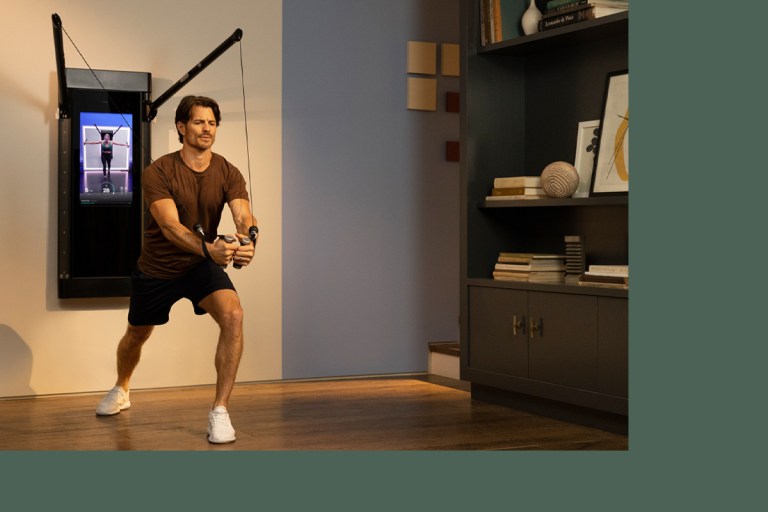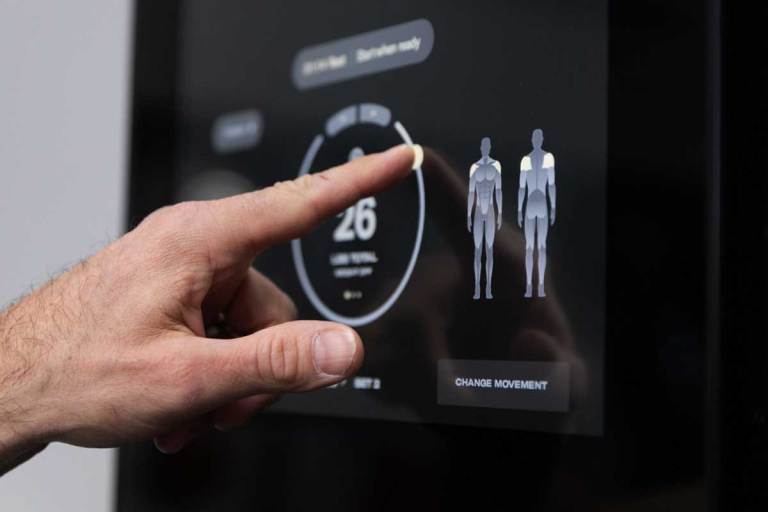Why Moving in Multiple Planes of Motions Boosts Athleticism
Here’s how you can use the three planes of motion to supercharge your training.

When you’re lifting and lowering the bar in a deadlift, or bending and extending your arms in a bicep curl you’re moving through a fixed path of motion. Outside of your workouts, though, you’re often moving in three dimensions — think: bending down to pick up a suitcase and pivoting to load it into the trunk of your car, or sprinting down the sidewalk to catch a bus and lunging sideways to dodge slow walkers. To move better throughout daily life, you need to ensure your training covers multiple types of movement.
“We’re supposed to move forward and back, side to side, and we’re supposed to be able to rotate,” says Kristina Centenari, a certified personal trainer and Tonal coach. “As functional human beings, we should be able to move strongly and competently in all of those ways.”
In training, those three types of movement are referred to as the planes of motion: sagittal (forward and back), frontal (side to side), and transverse (rotational). Picture the planes of motion as three pieces of glass dividing the body into different halves. The sagittal plane divides the body into right and left halves, the frontal plane splits the body into forward and back halves, and the transverse plane cuts the body into top and bottom halves. Movements that run parallel to a dividing line fall into that specific plane of motion.
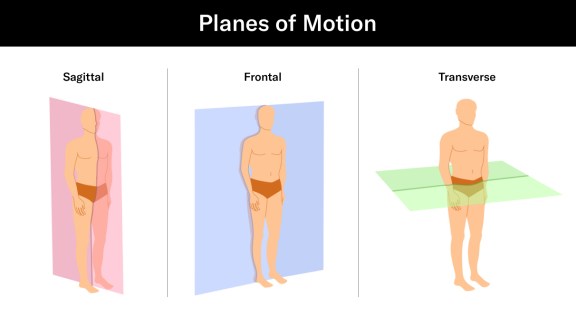
“Once you understand [the three planes of motion], it just unlocks this whole new potential of your training that people may neglect,” says Jenna Moore, a certified strength and conditioning coach and Programming Specialist at Tonal.
Because we naturally move in all three planes of motion in daily life, it’s essential to practice them in your strength training. Think about balancing out your movements in each plane of motion, just as you vary between upper- and lower-body exercises or pushing and pulling moves. According to Moore, multiplanar training improves overall movement efficiency, athleticism, and resilience against injury by building stability in your tendons and ligaments.
“You can’t generate force in ranges of motion you can’t reach,” says Centenari, “so it’s really important to not only train those ranges of motion but to load them and strength train within them.”
For a sample of programming that includes all three planes of motion, try the two-week program Pre-Season Performance on Tonal. Each week includes one day per week dedicated to each plane of motion with a fourth day devoted to aerobic conditioning.
To make sure you’re including all three planes of motion in your training, here’s a breakdown of what movement in each plane entails, along with sample exercises for each:
Sagittal Plane
“The sagittal plane is your up-and-down, forward-and-back plane of motion,” says Centenari. To visualize the types of movements you can do in the sagittal plane, Centenari says to imagine you’re standing with two walls on either side of you. Within these walls, you’d only be able to move forward and back or up and down.
Movements in the sagittal plane usually involve joint flexion and extension. This could be bending your elbows in bicep curls or flexing and extending your hips in a deadlift. Most of our joints, including the hips, knees, elbows, shoulders, and spine, are capable of flexion and extension, so there are lots of exercises in the sagittal plane.
Between walking, running, picking up grocery bags, and reaching up to turn on a light, most of our daily movements are in the sagittal plane of motion. Most classic strength training exercises are also in this plane of motion, so Moore says these movements are likely already part of your regular training routine.
Bicep Curl

How to Do it: Holding the handles, stand tall with arms extended by your hips. Flex the elbows to bring your palms toward your armpits like you’re cracking a walnut between your forearm and bicep. Extend the elbows to bring your hands back to your hips and repeat.
Racked Squat

How to Do it: Facing Tonal, take a handle in each hand and bring them to your shoulders with palms facing each other. Stand with feet hip-width apart at the end of Tonal’s arms. Move through your hips as your knees bend like you’re sitting back into a chair. Stand by squeezing your glutes and pushing the floor away from you.
Frontal Plane
The frontal plane is the side-to-side plane of motion. “If you had a wall in front of your nose and behind your head, you’d be able to go left and right,” explains Centenari.
Movements in the frontal plane involve abduction or adduction in the joints, or moving the limbs away from or toward your midline, respectively. Since not all joints are capable of abduction and adduction, explains Moore, these movements are less common than sagittal plane exercises. Strength training in the frontal plane usually recruits the hips or shoulders, as these are the major joints capable of this type of movement.
Resisted Lateral Lunge
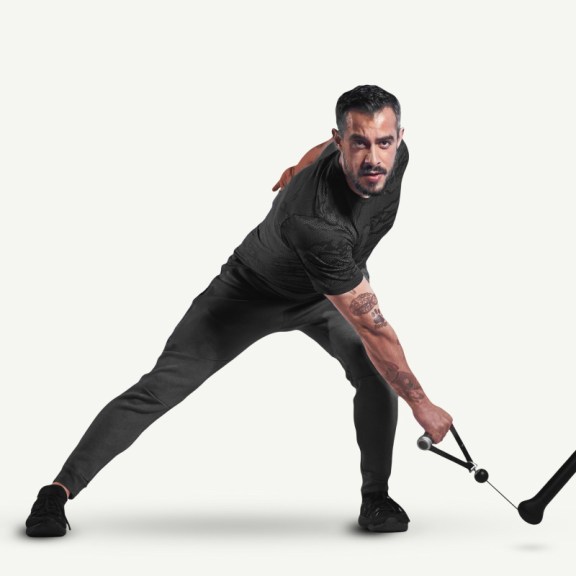
How to Do it: Take the handle in one hand and take a few large steps away from Tonal. Stand sideways so the handle is on the far side of your body with the cable crossing in front of you. Take a wide step toward Tonal and sit back into your inside leg like you’re sitting into a chair while keeping the other leg straight. Press the floor away from you with the inside leg and return to standing. Repeat on the same side.
Lateral Raise

How to Do it: Take a handle in each hand and stand facing away from Tonal. With soft elbows, lift your arms up to your sides toward the ceiling until they reach shoulder height. Lower the arms with control and repeat.
Transverse Plane
The third plane of motion, the transverse plane, refers to rotational movement. Although transverse plane movements might not get a lot of attention in your training, they’re fairly common in everyday life. Think about sitting in the front seat of your car and twisting around to grab something from the back, pivoting to your side to get out of bed in the morning, or even turning your head side to side. Swinging a golf club or tennis racket are also examples of rotational movements.
Exercises in the transverse plane, such as seated twists in yoga or Russian twists targeting your core, often involve rotations at the spine or hips. However, movements that involve bringing your limbs toward and away from your body horizontally are also considered transverse. Think back to the idea of the transverse plane as a piece of glass bisecting your body at the midline. When you’re lying down in a bench press, the movement of your arms would be parallel to this imaginary piece of glass. Therefore, exercises such as bench presses, chest flys, and push-ups are actually in the transverse plane. Technically, Moore explains, these moves qualify as transverse because they’re done with your shoulder joints rotated horizontally.
Rotational Chop

How to Do it: With your inside leg, press the floor away from you and rotate the pelvis to shift your body into the outside leg. Rotate at the torso and bring the rope across your body and down toward your inside hip like you’re buckling a seatbelt. Bring the rope back to start, sit into the inside hip and repeat.
Goblet Curtesy Lunge
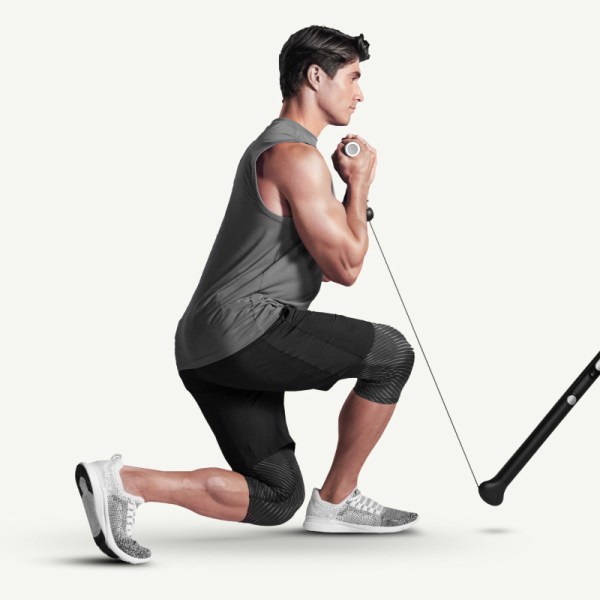
How to Do it: Hold the handle at the strap with thumbs wrapped around the top. Position it in front of your chest and stand tall at the end of Tonal’s arm. Reach one leg back to lower down, dropping the knee toward the mat. Just before the knee reaches the mat, cross it behind the planted foot, just outside the ankle like a curtsey. Press the floor away from you with the glute of the front leg to power up and repeat on the same side.
The Bottom Line
Living in three dimensions means always being ready to move in different directions. By training in the three planes of motion, you’ll prepare your body to move more powerfully, feel stronger, and avoid injuries. Take a look at your training and make sure you’re including a mix of sagittal, frontal, and rotational movements to optimize your potential.
